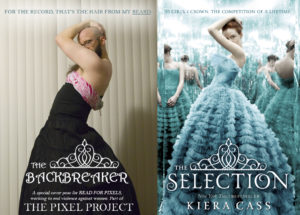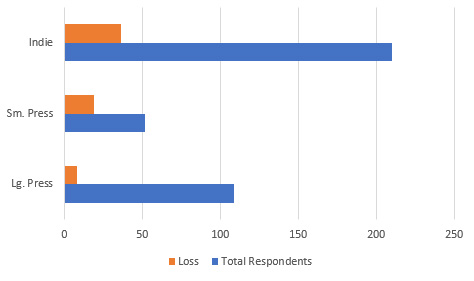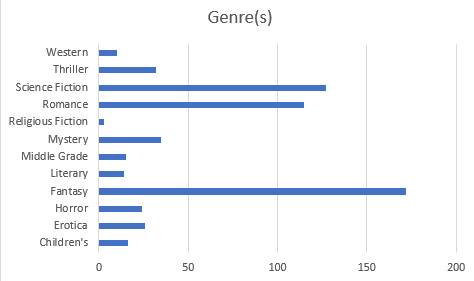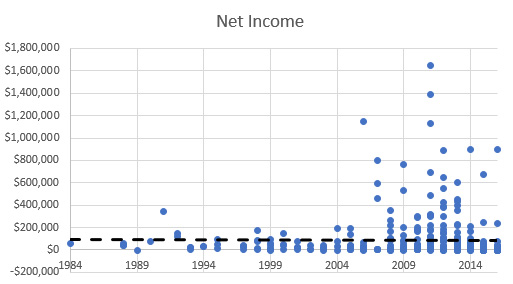State of the Jim: Terminal Alliance, Invisible 3, and More
Life has been…let’s call it hectic. A random sampling of recent excitement includes a minor car accident (everyone’s fine), a $200+ insurance mix-up (I think they’re straightening it out now), a podcast interview (I’ll post links when it goes live), increased work at the 10 hours/week day job, and more.
All manageable, but there’s been an ongoing sense of running without ever getting a chance to stop. (Though Amy and I did sneak out to see Logan earlier this month. Yay!)
And then there are the various writing-related projects. Here are the updates on those!
Terminal Alliance
As some of you may have seen, the official release date for Terminal Alliance has been moved back to November 7. This is on me. Writing my first science fiction novel has taken longer than I anticipated, and I’ve needed additional time to make it as good as possible.
Happily, I turned a complete manuscript in to my editor last week, and am now working on final revisions. Everything is on schedule for that November release, and I’m happy with how the story and characters have turned out.
I’m particularly happy with the cover art Dan Dos Santos did for the book. The big cover reveal has officially been scheduled for this coming Monday, March 20. I can’t wait to show it off! There should be a giveaway to go with it.
Invisible 3
Mary Anne and I have responded to all but five submissions, and we’re hoping to get back to those people within the next week. I’m really excited about the essays and poems we’ve accepted so far. We don’t have a firm schedule yet, but I expect we’ll see some of the essays as guest blog posts next month, with the anthology going on sale in either late April or May.
Other Writing
I revised and returned a story called “The Fallow Grave of Dream” for the anthology The Death of All Things. The story has not been officially accepted or rejected yet, but regardless what happens, I’m very proud of this one. It’s short — only 2700 words, and the first story I’ve ever done in present tense, second person. It’s about death and dreams and disability and family and love and hope and despair, and it’s just really different from anything I’ve done before. One way or another, I look forward to sharing it with you.
Obligatory Hugo Reminder
For those of you doing your Hugo noms, my Magic ex Libris series is eligible for the Best Series Hugo, and our cat Chewie is eligible for Best Melted Cat.
Cool Stuff Friday
Friday may have spent too much time talking about Pokemon Go on that interview he recorded last night…
- Puppies on their first days at work.
- Dog photographer specializes in goofy expressions.
- When bookstore employees get bored. (Someone appears to be a fan of Charlaine Harris!)
- Very Good Dogs.
Nova, by Margaret Fortune
 I am shamefully overdue on reviewing Margaret Fortune‘s book Nova [Amazon | B&N | IndieBound]. I’d been hoping to review and provide a blurb before the sequel came out. Since the sequel was released on Tuesday of this week, it looks like I blew it.
I am shamefully overdue on reviewing Margaret Fortune‘s book Nova [Amazon | B&N | IndieBound]. I’d been hoping to review and provide a blurb before the sequel came out. Since the sequel was released on Tuesday of this week, it looks like I blew it.
Here’s some of the publisher’s summary:
Lia Johansen was created for only one purpose: to slip onto the strategically placed New Sol Space Station and explode.
But her mission goes to hell when her clock malfunctions, freezing her countdown with just two minutes to go. With no Plan B, no memories of her past, and no identity besides a name stolen from a dead POW, Lia has no idea what to do next. Her life gets even more complicated when she meets Michael Sorenson, the real Lia’s childhood best friend.
There’s a lot going on here. In some respects, this reads like a pretty standard coming-of-age story, with Lia learning about herself, developing relationships and a romantic interest, and finding purpose. In space!
It’s enjoyable on that level, and for a good 3/4 of the book, Lia’s personal growth takes center stage. But all this is happening against a background of interplanetary war, in which Lia is a literal weapon for the other side. Fortune sprinkles hints and clues as we go, preparing us for the big revelations at the end.
I guessed one of those revelations pretty early on. Others were more of a surprise. The pace really picks up as we learn the truth about Lia’s past and the war she’s fighting. I had a really hard time putting down the book during those final chapters.
In some respects, it reminded me of reading Heinlein as a kid — engaging teen protagonist and interesting space stuff, all written in a way that pulls you along for the story. (But without the more problematic aspects of Heinlein.) The fact that her glitched clock keeps starting and stopping, slowly whittling away the seconds, adds a nice layer of tension and conflict.
I would have liked to see Lia grapple a bit more deeply with the fact that she’s both a suicide bomber and the bomb itself, but the ending resolves that pretty well.
All in all, a fun read. I suspect more experienced SF writers might find parts of it familiar, but it’s still enjoyable. (And best of all, the ebook edition is currently on sale for $1.99.)
Book two of the five-book series, Archangel, came out on March 7.
2016 Novelist Income Survey Final Results and Data
I’ve compiled the 2016 Novelist Income Survey results into a single pdf report. I added a few things and corrected a couple of errors and omissions. You can download that report at the following URL:
http://www.jimchines.com/wp-content/uploads/2017/03/2016-Novelist-Income-Results.pdf
You can also check out the anonymized data at:
http://www.jimchines.com/wp-content/uploads/2017/03/Results.xlsx
This has been a lot of work, but I think the results were worth it. Thanks one final time to everyone who contributed in any way, from sharing your data to spreading the word to offering suggestions and critique on my analyses.
If you see any mistakes, please let me know. Otherwise, I’m gonna go take a breather…
Cool Stuff Friday
Friday finally caught a party-hat Pikachu!
- Flying dogs!
- LEGO machine folds, launches paper airplanes.
- Finalists in the Smithsonian.com photo contest. Some amazing and gorgeous pictures here.
A $500 Cover Pose
I consider myself mostly retired from the cover pose game these days. But when Regina Yao of The Pixel Project asked me to help out with one of their fundraising drives, how could I say no?
A very generous donor contributed $500 to The Pixel Project for their work to end violence against women. For that donation, they got to choose a cover for me to try to duplicate. They decided to go with The Selection, by Kiera Cass.
Click to enlarge the image…if you dare.
Thanks as always to my wife Amy, who took the photo and helped me get the pose right. Which included positioning a large exercise ball between my legs to get the poofy-skirt effect…
2016 Novelist Income Results, Part 5: Miscellaneous Data
Introduction
This is the fifth and final chunk of data and analysis from the 2016 Novelist Income Survey.
This is where I look at all the other random and miscellaneous data points that either didn’t fit elsewhere, or else I couldn’t figure out quite what to do with them. After this, I’ll be pulling everything together into a single downloadable report for folks.
Who Lost Money in 2016?
One thing I found interesting — of the 371 people who provided gross income and expenses data, 63 ended up with a net loss in 2016. In other words, roughly one out of six published novelists lost money last year.
17 of these identified as full-time writers, with the other 46 being part-time. Looking at the overall number of full- and part-time respondents, the part-time authors were disproportionately more likely to end up in the red.
How did those 63 authors break down in terms of indie/small press/large press?
- Indie: 36
- Small: 19
- Large: 8
Comparing those numbers to the overall breakdown of indie/small/large press gives us the following graph:
We can also look at the percentage of novelists who lost money in each category, which is perhaps a little more illuminating.
- Indie: 17%
- Small: 37%
- Large: 7%
As always, be careful about drawing too many conclusions from this.
Genre Breakdown
I messed up on this part. I asked people what genre(s) they published in during 2016, and let people check as many boxes as they liked, with an additional field for “Other.” This meant I got pretty accurate data, but a lot of folks selected multiple genres, which made it harder for me to do much with the data. In the future, I think I need to ask people to choose their primary genre instead.
Looking at which genres were chosen, we can see that the data are slanted toward SF/F and Romance.
As a SF/F person myself, it makes sense that my outreach on the survey would bring in a lot of my fellow SF/F authors. Basically, what this means is that the results and conclusions may not apply as strongly to, say, religious fiction as they do to fantasy or romance.
When Did You Publish Your First Book?
What happens when you plot net income against the year the author published their first book?
I removed one outlier — an author who made close to five million, and whose first book came out near the middle of the range. The results were not what I expected.
That trendline is pretty much horizontal, suggesting little to no relation between how long you’ve been publishing and how much money you make. Running the correlation function in Excel gave a correlation of 0.01.
I can see several ways of thinking about this. One is that you can spend 30 years writing books, and it doesn’t mean you’re more likely to be financially successful. Which is depressing as hell. But maybe it just means financial success can come at any time. Or maybe writers who broke in a long time ago aren’t as prolific these days, which is why their income was comparable to newer authors who might be more active?
I honestly don’t know, and I suspect you’d need a lot more analysis — and probably a lot more data — to draw any firm conclusions here.
Almost Finished
That’s pretty much everything I can do with the data. All that’s left now is for me to pull it all together into a single report. I’ll be incorporating some of the feedback and suggestions from the comments as well, thank you. I’ll also be anonymizing the data and sharing that for folks to play with.
I hope this has been helpful and illuminating for folks!
Cool Stuff Friday
Friday’s thinking he may have made his villains a bit too competent in this book…
- Yes I would like some galaxy cake please!!!
- Amazing hot-air balloon pics from Cappadocia, Turkey
- Action-figure photography, from hotkenobi
- Astrophotography goals
2016 Novelist Income Results, Part 4: Impact of Marketing and Promotion
Introduction
This is the fourth chunk of data and analysis from the 2016 Novelist Income Survey.
For this part, I wanted to look at whether the hours spent on marketing, promotion, and outreach correlated at all with how much money our authors made last year.
Overview
I used net income again, which means I removed data points where the authors hadn’t reported their expenses. I also eliminated two data points where respondents said they spent over 1000 hours/week on promotion and marketing. (If I’m wrong and those two authors have been using a TARDIS, I’d ask them to email me. And also to let me borrow their TARDIS.)
This left us with data from a total of 371 authors.
I then did a bit of Excel self-teaching to figure out how to use the correlation function. (In the previous section, I simply graphed out number of books and net income, and inserted a trendline. Calculating the actual correlation is more accurate, and I’ll be doing that for the previous part as well when I do the final write-up.) Yay, learning!
A correlation of 1.0 would be a perfect positive correlation. Likewise, -1.0 would be a perfect negative correlation.
Finally, in addition to analyzing the overall data, I also broke it down by authors who were primarily indie, small press, and large press, because I had a feeling there’d be a difference there.
Overall Results
Looking at all 371 authors together gives us the following graph. The trend line suggests a slight correlation.
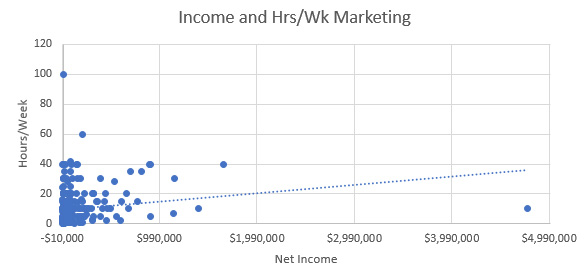 Excel gives a correlation of 0.16. That’s a very small positive correlation. Is it a significant correlation? I’m not enough of a statistician to say for certain, but it’s on the low side.
Excel gives a correlation of 0.16. That’s a very small positive correlation. Is it a significant correlation? I’m not enough of a statistician to say for certain, but it’s on the low side.
Subgroup Results
So let’s look at the correlation scores for different groups of authors.
- Large Press: 0.06
- Small Press: 0.13
- Indie: 0.36
In other words, the strongest correlation between promotion/outreach/marketing and net income is for the indie authors. Which shouldn’t really surprise anyone.
On the other end, the amount of time spent on marketing and promo had pretty much no relation to overall income for the large press authors.
Removing the millionaires increased the correlation for large press slightly, and decreased slightly for the indies. But the correlation remained noticeably stronger for indie authors than for large/small press authors.
Conclusions
Does this mean the time and money I spent last year as a large-press author traveling to signings and conventions and doing online promotion was completely wasted? Not necessarily. We’re looking at overall trends, and any individual data point might buck a given trend. (Also, correlation =/= causation. I think I’ve said that on every post so far.)
There’s also the question about how you’re spending that time. 20 hours spent standing on a street corner wearing a BUY LIBRIOMANCER! sign probably wasn’t as effective as 20 hours spent researching reviewers and sending out targeted review copies of my book.
That said, I think the data supports the general wisdom that if you’re self-published, it’s a lot more important to spend time on marketing and promotion. Whereas if you’re with a large press, there’s a good chance your marketing efforts won’t have much of an impact on your bottom line.






